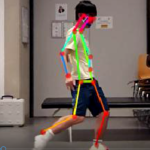Hello everyone,
So far, we have been through EMG pre-processing, timing analysis, and amplitude analysis … What is next?? It is frequency analysis. This is an interesting part of EMG analysis because EMG tell us about not only EMG amplitude, but also EMG frequency. How important is it ?? In general, fast twitch muscle activities are shown as high EMG frequency, and slow twitch muscle activities are shown as low EMG frequency. Therefore, if a person is doing fatiguing exercise, high frequency parts of EMG fall down, but its low frequency parts stay. Hope I see the pattern with my EMG data …
Procedure
1, Pre-processing data
I am explaining how to pre-process data in my previous blog and video, so please check them out!!
2, Timing analysis
I am explaining how to conduct timing analysis in my previous blog and video, so please check them out !!
3, FFT (Fast Fourier Transform)
FFT is an algorithm to transform EMG data from time domain to frequency domain. As you saw the EMG amplitude plot on my previous blog, x-axis of the plot was time, but FFT finds amplitude over frequency. Therefore, x-axis of the plot becomes frequency. the plot looks like this …

As you can see, the EMG signal contains frequencies from 10 upto 550. If you remember, I conducted bandpass filter in pre-processing section with cut off frequency of 10 and 500. Therefore, all frequencies outside of the band are almost gone.
4, Mean frequency analysis
Mean frequency is a common parameter which is used for frequency analysis. As it is named, we just find a mean frequency in defined time window. The plot looks like this …

The black line is the mean frequency of this EMG signal. It is around 100 Hz. The plot itself does not tell you anything. You may have to find something to compare… Therefore, I did mean frequency analysis in each muscle and in each trial. The plot looks like this …

I mentioned in amplitude analysis, but to compare one muscle with another muscle or one trial with another trial, you have to normalize the data. MVC (Maximum voluntary contraction) trial is usually conducted, and its data is used to normalize. I wish I had the data …, but I promise I will show you how to normalize data in another data I have in another time. It is sad we cannot compare, but we can find a pattern instead ! As you can see on the plot, right semi-tendinosus is the highest mean frequency. Right bicep femoris is the second highest. Left bicep femoris is the third highest. Left semi-tendinosus is the lowest. It may tell that right hamstring is more activated compared to left leg.
5, Median frequency analysis
Probably no explanation would be needed because this is just median version of mean frequency analysis. Median frequency of all muscles in all trials is below …

You can observe the same pattern as you see it on mean frequency analysis. However, amplitude of median frequency analysis is underestimated compared to mean frequency analysis. Both methods are used on several research, so both are valid, but you may want to stick to either method in one research.
I was going to finish here, but I went a bit further. As I did it in amplitude analysis, I found median frequency of 1 second around 20, 50, and 80% of entire EMG. The principal is the same as what I did in amplitude analysis, so please go back to my previous blog for details.
The plot looks like this …

As you already notice, y axis should be frequency, not amplitude, but the plot is correct. Anyway, I expected that frequency decreases from 20 to 80% or from trial 1 to trial 5, but I cannot see the pattern for right bicep femoris… Maybe right bicep femoris was strong enough, or the exercise was not fatigable enough. You may find something interesting in different muscles, so play around with my data and code below !!
6, STFT (Short Time Fourier Transform)
As you may realize, FFT removes the time component. It helps you observe which frequency in which amplitude, but you do not know in which timing. STFT still does FFT, but it can keep the time component, so you know which frequency in which amplitude, and in which timing. The STFT looks like this …

As you can see, this is 3D plot, so you can see time, frequency, and power on the same plot. It seems that frequency and amplitude do not change throughout muscle activation time. In STFT, you can manipulate resolution in time and frequency wise, but it is a trade-off (High time resolution, but low frequency resolution or vice versa). Therefore, you need to play around the parameter to find the best-fit for your own EMG data.
My YouTube video
I am explaining all procedures on my YouTube video, so please check it out !!
MATLAB code and EMG data
Enjoy!!













You have observed very interesting details! ps nice internet site. Leyla Nathanael Lowry